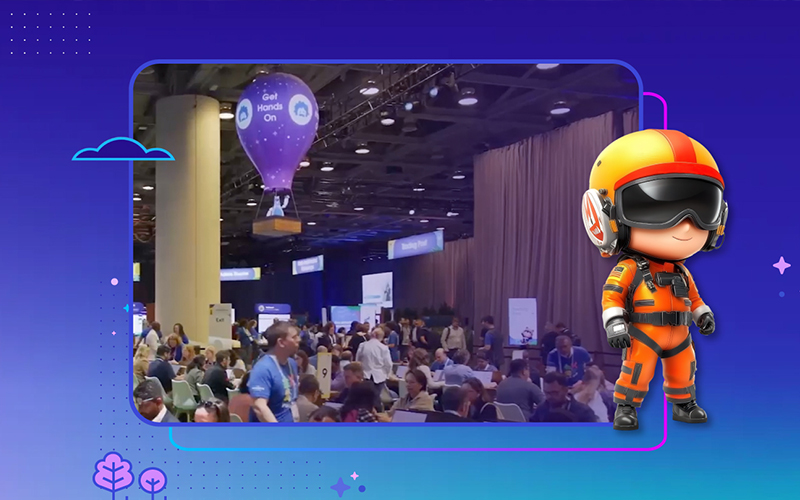
For some of our prospects and new customers, there is a misconception we have to address early on in our engagements — the idea you build an application, launch it on the AppExchange, and Salesforce will be handing new leads and customers to your company by the bucket full. With over 150K+ customers around the globe, Salesforce account executives (AEs) and Partner Account Managers (PAMs) are overwhelmed by the number of partners in the ecosystem. They need materials and information presented in a way they can quickly understand what your product is, how it works, where it fits within their sales strategy, and your target market and ideal customer profile.
Smart partners know you have to sell with Salesforce — the best partners know how to sell with Salesforce.
It’s essential to know all of the ins and outs of your business and product offering(s) to be successful with Salesforce and on the AppExchange. After all, if you don’t know every aspect, how can you expect Salesforce’s reps to be equipped with the right knowledge to sell your product alongside you?
There are many aspects you need to be familiar with to sell with Salesforce effectively. We’re going to focus on three key areas to get you started to enable you to create an outstanding sales kit — your product, the competitive landscape, and your customers.
Define Your Product
Knowing your product(s) and their value is essential for your success — you built it, you sell it, and you experience it every day — but how can you communicate with Salesforce AEs in a way they will understand it?
You must hone your value proposition and create an effective elevator pitch specifically for Salesforce. An elevator pitch is a brief description of your offering that clearly explains what the product is, what it does, why it’s needed, and how it will achieve it.
To refine your value prop and elevator pitch, start by asking yourself these six questions:
- What does your solution solve for?
- What value does your product bring to Salesforce customers?
- What Salesforce products does your solution complement?
- What industries are you looking to target (Healthcare Life Science, Financial Services, Manufacturing)?
- What segment are you looking to target (SMB, mid-market, enterprise)?
- What are your mutual customer success stories?
While this is by no means a comprehensive list of questions, defining the top three benefits of your app is extremely useful in being able to differentiate yourself and explain its value. It’s important when selling with Salesforce, to understand precisely how your product fits within the ecosystem and augments Salesforce’s functionality.
As we discussed in our Spearfishing in the Salesforce Ecosystem Webinar, your pitch must be explicitly focused on Salesforce and presented in the right context based on the goals of the person you are speaking to. Your AE will have different goals than your PAM — and your PAM will have different goals than your Sales Engineer (SE).
The Power of Your White Space
One area new partners often fall short on is carving out and defining how their product fills white space in the ecosystem. While Salesforce is a major powerhouse with a broad industry reach, there are still numerous pockets Salesforce has yet to penetrate. In fact, Salesforce calls white space the “golden ticket” to gaining mindshare with their AEs.
Each year, the sales and strategy teams review under-penetrated accounts in the Commercial Business Unit and Enterprise Business Unit market segments. For these areas with under-penetration, extra emphasis is placed on the teams to find a way in and provide the best possible solution.
If you sell to non-Salesforce customers, note who they are, as nothing perks up an AE’s ear more than landing a new logo. After you’ve built a relationship with your AE, ask them about their white space customers and define the co-selling strategy yourself. This will require a clear understanding of Salesforce, your product, and these various white space accounts, but by taking the time to create and present your findings to your AE, you’ll become a trusted partner.
When we look at the story of SpringCM, they filled a white space by providing a secure cloud platform that optimizes the generation, workflow, and archiving of mission-critical business documents across an organization. SpringCM manages contracts and all types of documents seamlessly across desktop, mobile and partner applications like Salesforce. Its suite of workflow automation tools eliminates manual and repetitive tasks. As CodeScience, we were able to solve some of their core business problems (check out the success story here) — and their results speak for themselves: Growing ARR by 160%, Increasing close rate by 125%, and driving customer retention to 96%.
Understanding the role your product plays in the ecosystem and being able to clearly and succinctly state what it does and why is valuable will help tremendously in setting yourself apart from the competition. However, you still have to know what your competition looks like.
Analyze the Competition
Depending on your product, you could be competing directly and indirectly with other partners and Salesforce at the same time — and since AEs make more money selling Salesforce products, you’ll have to create a compelling story that convinces AEs your product is worth their time. This is where the three differentiators and value prop come into play.
Before being able to disqualify your competitors, first, you have to identify who your direct and indirect competitors are. Start by listing out your direct competitors, then move to identify the not so obvious ones.
From here, Salesforce suggests you ask the following:
- Is your application fighting for mindshare with Salesforce solutions? Keep in mind — Salesforce products are familiar, and the deals have a direct and straightforward impact on the AEs’ quotas.
- Do customers know your solution exists? I.e., is your primary competitor the status quo?
The objective of this competitive analysis is to arm yourself with everything you need to win business when competing with another similar product offering. With the three key differentiators, you will need to convince AEs to be more strategic with their product choices by showing them your product is a better fit for the issue presented. Visual resources are a great reference tool for AEs to quickly understand your solution and where it fits.
Identify Your Ideal Customer
Now that you know your product and competition, it’s time to define your ideal customers so Salesforce reps can easily identify a good fit. Salesforce has over 150,000 customers, so there are too many to individually target and hope they purchase.
A great place to start is with your existing customers — they chose you for a reason, and you can analyze their characteristics and build out your ideal customer profile (ICP). By understanding the accounts you won, you will be able to see similar traits, demographics, and budgets — all of which provide the foundation to your ICP.
With this information in hand, you can narrow down the field of accounts for AEs. They’ll be able to identify a good opportunity when they see one — and get you involved during the sales process. Salesforce recommends seven categories to consider while defining your target customers:
INDUSTRY – Industry focus — In what industries do your customers operate? Salesforce has teams that specialize in industries such as Retail and Consumer Packaged Goods, Healthcare Life Sciences, and Financial Services.
MARKET SEGMENT – Employee count — How many employees do your customers have? Salesforce has sales team segments for each company size
REGION – Location — Where are your customers located? Salesforce has hubs worldwide: North America (New York, San Francisco, Chicago, Toronto) Global (London, Tokyo, Amsterdam, Paris)
PRODUCT INTEGRATION – Platform — Does your product support multiple Salesforce Clouds?
LEGACY INTEGRATIONS – Third-party products — Does your product integrate with third-party applications? Does it replace legacy on-premises solutions?
PAIN POINTS – Customer pain points — Does your customer have easily identifiable issues in common that costs lots of time and energy?
DEPARTMENT SPECIALTIES – Front or back office—Salesforce has a lot of business with client-facing customers. If your product serves a need in the back office, you can help Salesforce reps expand into this space.
Through this segmentation, you can more accurately define what an ideal customer looks like and focus more of your efforts there.
By taking the time to ask yourself these questions and go through this process, you are arming your company with the tools it needs to gain mindshare and become a trusted partner at Salesforce. With these resources, you have already put in more effort than most of your competition. If you are looking for some more information directly from Salesforce, check out the Partner Business Planning Trail.
Are you watching your timelines slip as you try to navigate the Salesforce ecosystem? Or do you have unrealized potential revenue from the Salesforce channel? We are here to help. As the first and only company to achieve Master Navigator PDO from Salesforce, we know what it takes to help any partner thrive. Get in touch today!


